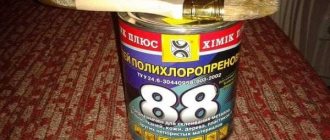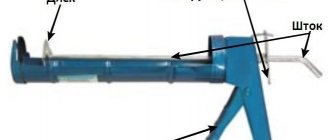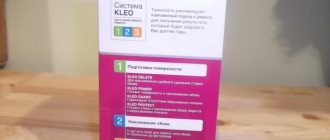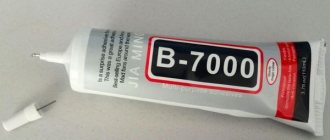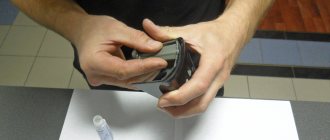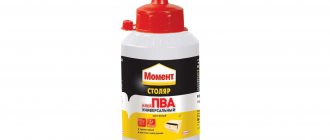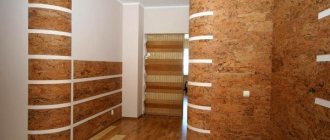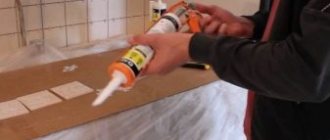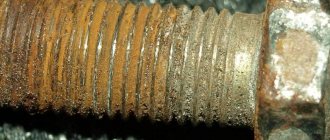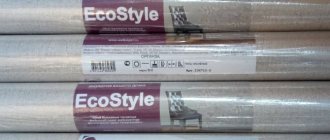BF-2 glue (phenol polyvinyl acetate) was developed by G.S. Petrov back in the middle of the 20th century, but there are still no analogues to it in composition. The adhesive mixture has a viscous, not too thick consistency, a pungent odor and not a very bright color. The technical characteristics of the composition guarantee strong bonding of any surfaces.
It is considered the best when restoring antique items. Suitable for modeling. Used in medicine (dentistry), in the furniture industry. The adhesive should not be used for kitchen or other products in which food is prepared, stored or consumed. It is actively used in the repair of acoustic equipment and radio devices.
Specifications
| Characteristic | Description |
| Appearance | Transparent liquid. Slight turbidity with a yellow or partially red tint is acceptable. |
| Conditional viscosity | 30-60 s at temperature +20°C |
| Dry residue fraction | 14-17% |
| Shear strength of adhesive joint | 19.5-20 mPa or 200 kgf/sq.cm. at a temperature of +20°C |
| Bend of the dried glue seam | < 3 mm |
The use of BF-2 provides strong adhesive seams with low elasticity. The glue easily withstands high temperatures (up to 200 °C). Working properties of the adhesive composition:
- invulnerability to mold;
- resistance to chemicals, acetone, gasoline and alcohol;
- viscosity in the range of 30-60 Pa*s at a temperature of 20-25°C.
The viscosity of the glue can be increased by storing it at sub-zero temperatures.
Before use, the product must be kept at room temperature for at least 1-2 days. Heating the product with a hairdryer or storing it near heating appliances is dangerous.
Characteristics and composition
Its properties during operation depend on the composition of the glue. There are several types of it: BF 2, 4, 6, 19, 88, 2N. The abbreviation itself stands for “butyraphenol”.
The numerical value after the letters in the name of the adhesive indicates the total percentage of polyvinyl acetal. The more it is, the more elastic the adhesive seam. However, along with this, its strength after drying will be proportionally lower.
The material looks like a not very thick liquid of medium viscosity with a characteristic reddish tint. It is resistant to corrosion, fungus, oils and chemical elements. In this case, the glue sets quickly and is consumed within normal limits.
The disadvantage of BF2 is its toxicity. Manufacturers recommend working with it in a well-ventilated room. Make sure there are no active fire sources nearby.
Areas of use
The use of BF-2 glue is recommended for joining parts that will not move during operation or be subject to dynamic loads. The result must remain motionless, otherwise the seam itself may become deformed. This is due to its inelasticity after hardening.
Glue can be used to connect:
- metal;
- tile;
- tree;
- marble and porcelain stoneware;
- glass;
- ceramics;
- polymer coatings.
The parts glued together can be of different materials, for example, a wooden base with glass or plastic with ceramics.
BF-2 has different release forms: tubes, cans and small bottles
Where and when is BF-2 glue used?
In accordance with the manufacturer's instructions, the main purpose of the adhesive mixture is gluing rigid parts and surfaces that are immovable during operation and do not experience operational dynamic loads.
The adhesive solution can be used to connect surfaces made of the following materials:
- metal;
- plastic;
- wood;
- marble;
- glass;
- ceramics;
- tile.
The composition is used for joining homogeneous and dissimilar materials. When working with this glue, it is necessary to apply the adhesive mixture in two layers (in accordance with the manufacturer's instructions) to ensure maximum quality of surface bonding. The adhesive solution can be applied hot or cold (the choice is made in accordance with the capabilities and requirements of the consumer).
BF-2 adhesives and other compounds from this series have been actively used in our country in the past for the repair of various acoustic devices. It can also be used as a varnish or impregnation composition for materials subjected to restoration or restoration.
Instructions for use
The composition requires double application of layers. BF-2 can be used to cover surfaces as an alternative to paint and varnish products and impregnation, for example, in the process of restoring something.
The instructions consist of a step-by-step process.
- Processing areas that need to be glued later. The work depends on the characteristics of the materials themselves, for example, metal needs to be cleaned with sandpaper and thoroughly wiped with a rag soaked in gasoline (or any other composition with a degreasing effect). Plastic and glass can be treated with a hot baking soda spray.
- It is better to apply the adhesive mixture with a clean thin brush on both sides. The glue layer should be thin and uniform. If it is applied cold, it takes 20 minutes to dry; when applied hot, it takes at least an hour.
- The second layer must be applied using the same method as the first (either cold or hot). There should be no gaps or leaks.
With the hot gluing method, the joined parts must be clamped in a vice and placed in the oven for 60 minutes. The internal temperature should be around 130-140 °C. When gluing cold, after applying the second layer, you need to wait 2-3 minutes, then press the parts tightly and leave everything in a warm, ventilated room for a day. The hot joining method can be used when working with marble, metal and earthenware. Cold – for the restoration of vases, dishes and various models. The part will be ready for use in no less than 24-48 hours.
If glue gets on the skin of your hands, it should be washed off with regular running water.
How to use glue?
To achieve a strong connection, it is necessary to prepare the surfaces to be glued: they must be well adjusted. The gap should be no more than 0.05 mm. They should be cleaned and degreased. If the parts to be glued are made of metal, they should be cleaned with a special “sandpaper” and washed with gasoline or another degreasing compound. For other materials, you can use hot water and baking soda.
Apply a uniform, thin layer of glue to the prepared surfaces and let it dry. This usually occurs within an hour with natural drying or within fifteen minutes in a chamber at a temperature of + 95 ° C. When the parts have cooled to room temperature, you can apply a second layer, which should dry a little, after which the parts to be glued are pressed firmly (for example, with clamps) and placed in a drying cabinet for about two hours at a temperature of 120-160 ° C.
Parts with low heat resistance can be dried for thirty-six to forty-eight hours at room temperature, but in this case the adhesive strength will be slightly lower. If the glue has thickened, dilute it with ethyl alcohol. Glue consumption is two hundred and fifty grams per square meter.
Storage and transportation
Phenol polyvinyl acetate glue brand BF-2 should be stored in hermetically sealed containers.
Do not allow it to be near a source of fire or possible fire. The storage place should be out of reach of children, dark and dry. The mixture itself can only remain in its original packaging.
Transportation is possible by rail, road, and air. The main condition is compliance with sub-zero air temperatures.
Storage conditions:
Store the glue in a hermetically sealed container at a temperature of 0 to 25ºС.
An increase in viscosity is allowed during transportation and storage at sub-zero temperatures. Before using this glue, it must be kept at a temperature of 25ºC for at least 3 days.
Warranty period of storage
glue from the date of manufacture for at least
10
months. After the warranty period has expired, the adhesive can be used for its intended purpose after checking its quality.
Do you know that…
The popular name for BF glue is “Boris Fedorovich”. Often used as a substitute for alcohol. To do this, water was added to the glue, a jar of glue was placed on a drilling machine (or milling machine), a drill (or a piece of welding electrode) was inserted into it, and the machine was turned on. As a result, during the rotation of the twist drill, adhesive substances collected on it, and a more or less pure solvent (ethyl alcohol) remained in the jar. This procedure was called "drilling out." The safety of the prepared drink depended entirely on the skill of the machine operator and, of course, on the composition of the glue itself. At home, to prepare an alcohol-containing liquid, they usually used a hand-held electric drill, with rags, ropes, etc. wrapped around the drill. The procedure for obtaining an alcohol-containing liquid at home was called “kicking out the heifer” (option: “kicking out the goat”). “Telkom” (or “goat”) was the name given to the mass of adhesive fraction concentrated on the drill.
Currently, the method is unsuitable, because BF has not been made with ethyl alcohol for a long time, and the chemistry on the basis of which the bulk of adhesives, conventionally called “BF”, are now made has been little studied by science and is certainly not good for health.
Glue BF-2.pdf
Analogs
There is not a single analogue of the BF-2 category. None of the manufacturers use phenol-formaldehyde resin as a component. You can choose a replacement that matches the technical characteristics of the BF-2 as closely as possible.
For example, “Super cement” has a reduced adhesion ability of the composition and the strength of the finished seam. Not intended for use on metal surfaces. You can try replacing the glue with any product made on the basis of epoxy resin. It is toxic and fire hazardous. This must be remembered before starting use.
The manufacturer has a variety of adhesive mixtures of the BF brand.
- BF-2n or BF-4n (only for ferrous metal).
- BF-4 can be used to maintain the elasticity of seams that will be susceptible to vibration.
- Medical glue BF-6 is the best option when working with textiles and leather, and is used in medicine.
- BF-19 is non-toxic, connects ceramics, wood and textiles (hot method), rubber, cardboard, leather and textiles (cold method).
- BF-88 is a fire hazardous product that firmly connects metal and non-metallic components.
All types of glue used in medicine (dentistry) are purchased in pharmacies or specialty stores that sell medical equipment.
Varieties
The BF series includes many adhesive compositions that were manufactured in the USSR and continue to be produced in Russia at several enterprises. The series includes the following products, in addition to BF-2:
- BF-4. It is used for joining highly elastic materials that will bend and be subject to vibration loads during operation. Scope of application: metal, wood, leather products, surfaces made of textolite, plexiglass, etc. Used for the production of getinax.
- BF-6. Used for joining flexible products and parts (leather, textile). Actively used in the medical field (dentistry).
- BF-19. Can be used for hot joining of glass, ceramic, wood, textile, and metal products. For cold gluing: paper, rubber, cardboard, polymer, fabric, leather items. It is highly toxic and therefore cannot be used in medicine.
- BF-88. Used for joining non-metallic and metallic products. Used in the medical field to seal large wounds. Non-toxic. Resistant to moisture and temperature changes. Combusts when exposed directly to an open flame.
- BF-2n, BF-4n. Limited scope of application - only products and parts made of ferrous metals.
All types of BF glue that can be used for medical purposes are usually sold in pharmacies or specialized medical stores. It is almost impossible to find them in hardware and construction stores. It is recommended to buy BF glue only at large specialized sales points. If the mixture is to be used for medical purposes, it is necessary to ensure that the composition is genuine and safe to use.
Review of BF glue (2 videos)
Glue BF-6 (15 photos)
Glue composition
Depending on the specific brand, the chemical composition of BF glue may be different. All products in the series are produced in accordance with GOST 12172-74.
By deciphering the name (butyraphenol glue), a specialist will understand that the main component is polyvinyl butyral (or polyvinyl acetal). The number after the BF brand indicates the percentage of the main component in the dry matter, which gives the material elasticity.
Different types of BF may have an unequal number of such components - the more there are, the higher the plasticity of the dry adhesive layer, but the lower the strength. The glue contains:
- phenol-formaldehyde or phenol-polyvinyl acetate resin;
- ethyl alcohol (solvent).
The last component can be replaced by the manufacturer with chloroform or acetone. Medical glue BF-6 is dissolved only with alcohol.
In appearance, all products are thick solutions of yellowish, brown, brown, reddish color. Adhesives are flammable.
